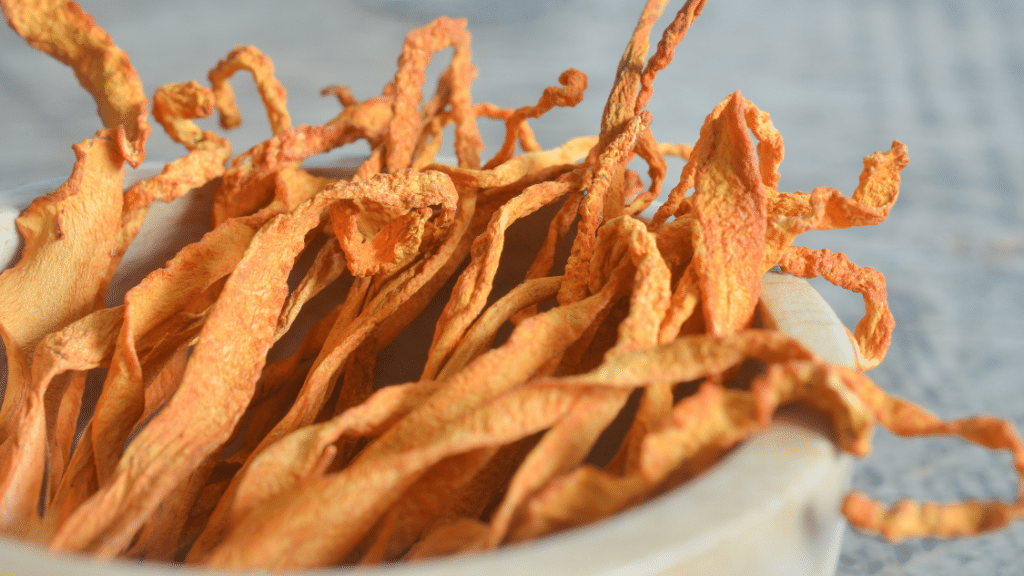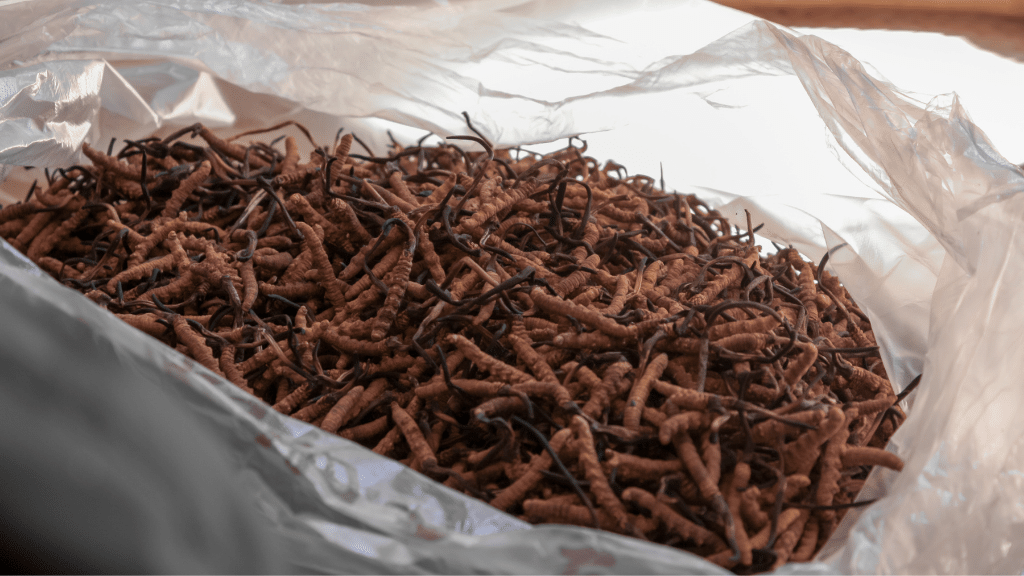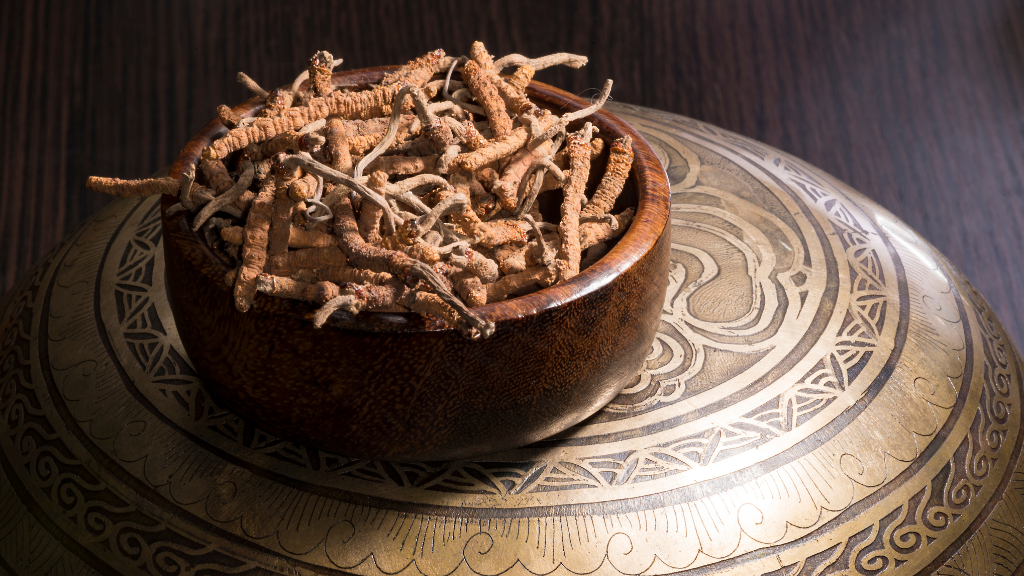Cordyceps is one of the most famous medicinal mushrooms in traditional Chinese medicine.
It’s known as the “caterpillar” fungus, because it grows on the larvae of insects.
In this article, we'll talk quickly about the benefits and history of cordyceps, and then dive into some of the potential side effects and drug interactions you should know about.
Let's dive in:
Where do cordyceps come from?

The wild (and most popular) species of cordyceps known as cordyceps sinensis is a rare and extremely expensive species, fetching up to $25,000 per kilo. This variety of caterpillar fungus is found in the high-altitude regions of Tibet, Bhutan, India, and Nepal.
In its history, local herders noticed that animals (sheep, goats, yak) were consuming it while they were grazing and that they became stronger because of it.
This sparked its use as a medicinal mushroom, which humans began to take for themselves.
Harvesting increased exponentially, which diminished the availability, leading to the significant price. Wild cordyceps sinesis mushrooms were - and still are - a global delicacy.
What are the traditional health benefits of cordyceps?
The people of North Sikkim, in India, praised cordyceps use for multiple benefits including:
- Increased longevity
- Erectile dysfunction
- Female aphrodisiac
- Infertility
- General weakness
- Tuberculosis
- Bronchitis
- Malignant Tumor
- Cough and cold
- Rheumatism
- Arthritis
- Jaundice
- Prostate enlargement
- Liver disease
- Heart disease
- Chronic pain
- Diabetes
And so the story unfolded, with more people using it to help support a variety of health conditions and illnesses.
But, with the diminishing yield and the rather insane price, it wasn’t sustainable to be offered as a supplement, which brings us to cordyceps militaris which was developed as a natural substitute that can be successfully grown on a larger, commercial scale.

It has very similar properties as cordyceps sinensis and may test higher in potency for select bioactive compounds.
Today, cordyceps militaris is widely popular based on its potential to deliver energy and athletic performance.
You can review a list of all the researched health benefits of both here.
When taking any new supplement, whether it’s medicinal mushrooms or something else, it’s important to understand the potential side effects as well.
Cordyceps side effects
Cordyceps has been relatively considered to be non-toxic with no major side effects.
This study presents an overview of cordyceps studies that have been conducted. And while it is generally considered safe, there have been instances of:
- Nausea
- Diarrhea
- Dry mouth
- Allergic reactions
In regards to nausea and GI issues, it’s best to monitor your dose and determine if it has any adverse effects. If so, it would then be best to discontinue use.
Different supplements, like cordyceps, affect each person differently. In order to help alleviate GI issues, it may be beneficial to start with a smaller dose or accompany cordyceps supplementation with food and/or water.
The same generalization can be said for those that may develop allergic reactions. Evaluate your own response and always discontinue use if you feel it's having an adverse effect.
There isn’t a significant amount of research on the side effects of cordyceps yet, so it’s also important to discuss any new supplement with your doctor/physician so they are aware of everything.
If you’re on other medications, you should also discuss it with your doctor in order to understand what interactions cordyceps may have.
Possible drug interactions with cordyceps
This study states that, “patients, who suffer from autoimmune diseases such as rheumatoid arthritis, systemic lupus erythematosus and multiple sclerosis, are generally suggested to avoid its use.”
While cordyceps has no known severe reactions with drugs, there is said to be some mild drug reactions. These may include but are not limited to:
- amikacin
- anamu
- cyclosporine
- danshen
- devil's claw
- gentamicin
- isocarboxazid
- kanamycin
- linezolid
- neomycin PO
- netilmicin
- paromomycin
- phenelzine
- prednisolone
- streptomycin
- tobramycin
- tranylcypromine
If you’re taking any medication, be sure to discuss the addition of a medicinal mushroom supplement with your physician and pharmacist. The list mentioned here may not be up to date and new research, provided by your doctor, could weigh in on other possible interactions based on the medications you’re taking.
Cordyceps dosage
 The typical recommended dosage of cordyceps depends on the form you’re taking. With raw cordyceps militaris (mycelia or fruiting body), the typical dose is between 4 to 10 grams per day. That's about 1-2 teaspoons.
The typical recommended dosage of cordyceps depends on the form you’re taking. With raw cordyceps militaris (mycelia or fruiting body), the typical dose is between 4 to 10 grams per day. That's about 1-2 teaspoons.
In regards to cordyceps extract, the dosage most commonly used in studies is between 1-3 grams or 1000 to 3000mg per day. That's about 1 teaspoon.
Based on the condition or “effect” you’re looking for, you may opt for a higher or lower dose.
Dosing can be different based on weight, age, and the desired use.
Why do people take cordyceps?
Along with the long list of potential uses by the people of North Sikkim, the primary uses, that have appeared in studies that cordyceps may support are:
- Enhanced physical performance
- Fights fatigue
- Help treat high blood pressure
- Anti-aging/longevity
- Improve sexual drive & function
- Slow tumor growth
- Type 2 diabetes support
- Kidney health
- Heart health
- Anti-inflammatory
We see most supplements on the market touting energy and performance, which is a common desire to start taking cordyceps supplements.
Looking for more on the applications and health benefits of cordyceps? Check out this article.
How do most people take cordyceps?
In general, the most common form of taking cordyceps is through supplementation of cordyceps extract.
Cordyceps extract typically goes through an extraction process of hot water and/or alcohol to make beta-glucans and other compounds bioavailable, meaning that we can absorb them.
The remaining product is a liquid extract (tincture) or the liquid extract has been dried and ends up as a powder, which can be taken commonly by a teaspoon and added into drinks, or as a capsule taken orally.
Learn more about extraction techniques and the benefits here.
Both have their benefits. Tinctures taken sublingually, underneath the tongue may provide a quicker benefit than a powder or capsule due to the rate of absorption.

Capsules and powders will be broken down and absorbed, but both offer similar, if not identical benefits.
It comes down to personal preference. Some people don’t like the taste of tinctures, and others don’t like the powder, even when mixed in drinks. Some may prefer capsules to block out any taste, while others prefer not to swallow capsules at all.
It really comes down to personal preference and what suits you best!
Looking to take a commercial capsule product? Check out our list of recommended brands here.
When is the best time to take cordyceps?
Based on its potential to support enhanced physical performance, an increase in energy, and fight fatigue, the best time to take cordyceps is in the morning or before a workout.
Many people choose to add it to their coffee or morning drink or take it alongside both.
Others have been known to take it as part of a pre-workout regimen to potentially help deliver more energy when they need to power through a fitness program.
We all look for something that can provide us with a natural boost of energy, and cordyceps may be that something.
We are looking forward to continued research and studies on this and will update you as more information comes to light!





.png)
